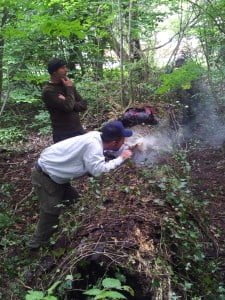Last week, finally saw the eagerly awaited Leafy Murder Mystery take place at Stoke Park. Organised by Katie Tomlinson, from the British Society for Plant Pathology, it aimed to introduce school children and members of the public to the roles that pathogens, in their various forms of fungi, bacteria and other microorganisms, play in causing illness and infection in plants. Sounds serious? It is!
In a subject that may normally be considered rather scientific and maybe beyond the average person’s grasp, the role of Leafy Murder was to introduce beginners to plant pathology, by presenting a series of clues for participants to solve, with the aim of ultimately finding out ‘who done it!’
Lockleaze Primary have a great day at Leafy Murder Mystery!
Lockleaze Primary have a great day at Leafy Murder Mystery!
So did it work? Most definitely!
On Friday, Lockleaze Primary were our Leafy Murderer Detectives. Many of them already knew Steve England, who was one of the experts delivering the event, and they followed him through the woods pied piper style, in a manner I have only ever witnessed with Pete the Bug man, who was also taking part, but sitting in a field somewhere, far away, surrounded by 2 legged, 6 legged and 8 legged creatures!
Steve’s engaging way of presenting and making science accessible to everyone, meant the children were transfixed. Stopping by a horse chestnut tree, Steve said, ‘this tree has a cold. How do we know it has a cold? Because it’s got snot? And what happens to you when you’re snotty? You get a sore and cracked nose. Same for a tree.’ At which point some child exclaimed – I can see its nose! And look, there’s its armpit! (You gotta smile!)
The walk continued, and children got the chance to squeeze the juices and gunk out of trees which had been rotted into nothing but wet sawdust by voracious fungi. They collected leaves which had been harmed by leaf miner moths for later inspection under a microscope. They pulled great lengths of boot lace fungi as long as their arms, from the innards of tree trunks. They passed around sticky jelly ears and marveled at the similarity, alongside shouts of ughhh! and yuk! Finally Steve demonstrated how a certain fungus could be used to sharpen a knife blade, and then, the piece de resistance, used King Alfreds Cakes like coals, to light a fire.
In the afternoon, they enjoyed a series of indoor activities in the Cameron Centre, which included examining a huge collection of varying fungi through magnifying lenses; using microscopes to look at bugs that predate on leaves (including a particularly fine sweet chestnut moth larvae, which wriggled and writhed just perfectly for its fascinated onlookers). They looked at examples of how plant pathogens affect our vegetables (amazing example of cabbage club root here – never seen anything like it!) and then had the chance to have a play and make something (pathogen like?) out of pom poms and pipe cleaners and win a prize! While all this went on, Polly, our UWE student who is evaluating Bristol99 interviewed children and encouraged them to add their feedback to the ‘feedback tree’.
The following day, we did it all again, and were joined by Dr Peter Spencer-Phillips, Head of UWE’s School of Biosciences in the Faculty of Applied Sciences, who added a slightly more scientific (but not too much) angle to the event. And at 5pm it was sadly all over. Katie Tomlinson was clearly delighted (if not exhausted) by the success of Leafy Murder Mystery and really has to be congratulated on putting such a clever spin on a subject, which until now, has been confined to the realm of the research scientist and academic. WELL DONE KATIE!!! (When’s the next one??!)
Reproduced with permission from Bristol99
